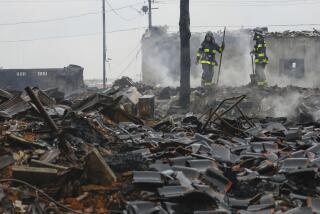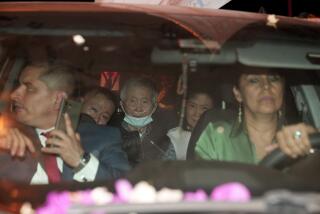Peru Weathers Aftershocks as Toll in Deadly Temblor Grows
- Share via
LIMA, Peru — Thousands of people left homeless by the year’s most powerful earthquake huddled in town squares Sunday and pleaded for tents, blankets and food as dozens more aftershocks shook cities and villages across southern Peru.
With the official death toll climbing to 71, soldiers scoured isolated mountain villages for more victims and distributed the first relief aid to protect people from the near-freezing nights of the Southern Hemisphere winter.
Earlier Sunday, John Minsch, a geophysicist at the U.S. Geological Survey in Golden, Colo., said the quake’s magnitude had been revised upward from 7.9 to 8.1 after further review of the seismic data.
Minsch said that given the 15,000 deaths that resulted from a magnitude 7.7 quake in India in January, “if the death toll does stay around 50 after all the information is in, I would say they are extremely fortunate.”
Juan Luis Podesta, the national chief of civil defense, told reporters that more than 800 people were hurt and about 12,500 had lost their homes. He also said that 16 of the deaths occurred in the coastal town of Camana when a tidal surge caused by the quake sent waves 500 yards inland, ravaging 5,000 acres of cropland.
In some communities, officials said, as many as 80% of the mud-brick houses were damaged or destroyed by Saturday’s temblor, which was stronger than any other quake in the world this year, according to the USGS.
Some people attended sidewalk Masses outside shattered churches, too frightened to venture inside. Residents began clearing fallen stonework that blocked narrow cobblestone streets in communities including Arequipa, Peru’s second-largest city, and the town of Moquegua, about 50 miles away.
One of the delicate bell towers of the historic cathedral in Arequipa crashed to the ground, and the other weakened ominously. Known as the “white city” for the light volcanic stone used to build many of its colonial-era buildings, Arequipa was declared a world cultural treasure last year by the United Nations Educational, Scientific and Cultural Organization.
With many phone lines cut and those that are still working overwhelmed by anxious family members, it was difficult to get a clear picture of the extent of the damage in the hundreds of villages scattered through the Andes and along the desert coast near the epicenter.
In Moquegua, Mayor Luis Dante Zubia said 80% of the homes were damaged, half of them beyond repair. He said the first relief flights arrived Sunday bearing food, generators and tents but that far more aid was needed.
People in Moquegua wore surgical masks or kerchiefs over their mouths to keep out the dust raised in the streets by collapsed masonry, according to television reports. They loitered in doorways of badly cracked houses or lay on mattresses outdoors for fear of further aftershocks, some of which reached 6.2 on Sunday.
Moquegua, Arequipa and other towns were inaccessible by road because landslides had cut the north-south Pan American Highway. In many villages, electricity, running water and phone service also were disrupted.
People with relatives in the quake zone anxiously called national radio stations begging for word on family members. And some in badly hit areas used ham radios to phone in damage reports.
Jose Acuna Espejo of Sara Sara in Ayacucho province pleaded for help for farmers, saying, “We need medicine, coats and tents because 80% of the houses have been destroyed.”
Southern Peru is frequently rocked by temblors. The Arequipa cathedral was badly damaged by earthquakes in 1687 and 1868. As in the past, authorities promised to rebuild the cathedral and other damaged historic buildings.
Interim President Valentin Paniagua, touring Arequipa and other devastated communities Sunday, pleaded for people to be patient. President-elect Alejandro Toledo postponed a trip to the United States and Europe so he could also tour the damaged areas to express solidarity with the victims.
The epicenter of the quake was near the coast 110 miles south-southeast of Puquio, Peru, at a depth of 20 miles, according to the USGS. It was felt as far away as Lima, the capital, about 600 miles to the northwest, and caused lesser damage in Arica in northern Chile and to the east in Bolivia.
The quake was similar in strength to a 1970 temblor that killed an estimated 70,000 people in Peru.
Foreign governments quickly pledged support for Peru, which is already facing an economic crisis. Juan Inchaustegui, minister of industry, said the country will seek credits from the Interamerican Development Bank to rebuild historic buildings that are a key attraction for tourists, a major source of Peru’s income.
Arequipa, at an elevation of more than 7,600 feet and framed by the snowcapped El Misti volcano, is one of Peru’s major tourist draws. The Spanish founded the city in 1540, and 60 years later it was destroyed for the first time by an earthquake and volcanic eruption.
*
Tarnawiecki reported from Lima and Smith from Mexico City.
More to Read
Sign up for Essential California
The most important California stories and recommendations in your inbox every morning.
You may occasionally receive promotional content from the Los Angeles Times.










